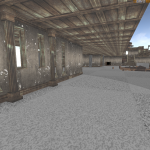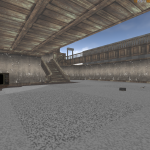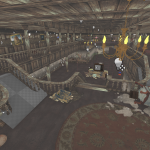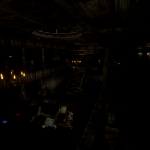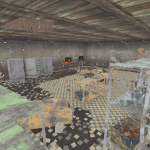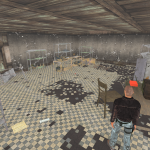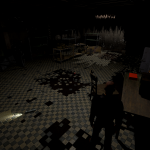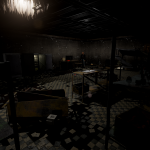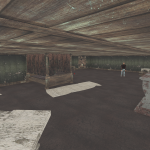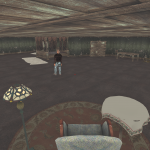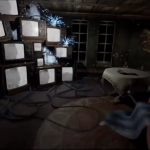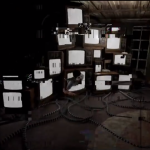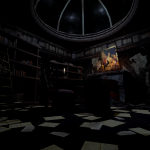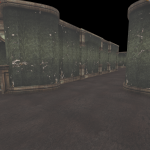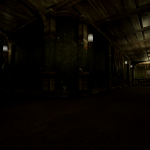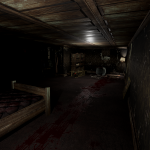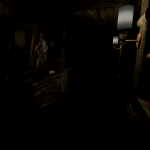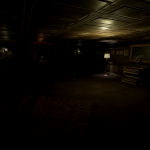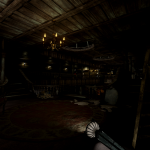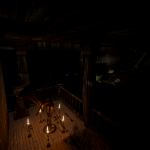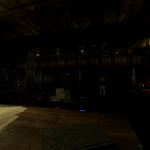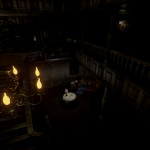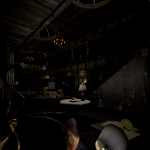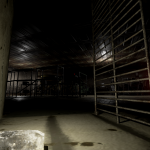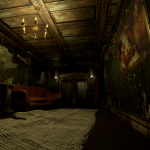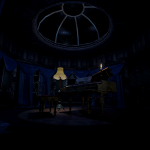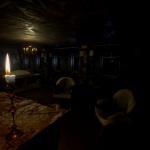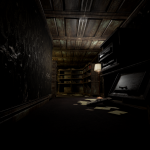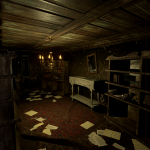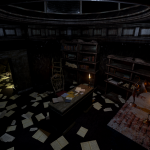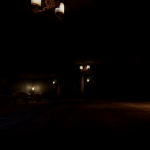– Genre: 1st-Person Atmospheric Horror Puzzle
– Engine Used: Unreal Engine 4
– Target Platform(s): PC
– Duration: 1 yr 3 mos
Split/Edit follows the story of an unsuspecting couple that enter an abandoned mansion for an urban exploration adventure, but get trapped inside. While exploring the mansion, they get attacked by a poltergeist that knocks them unconscious and takes them to a machine where that teleports them into their own version of a mad scientist’s horrific home videos.
Players will need to explore a decrepit mansion filled with old video equipment and an uncomfortable amount of television sets as they collect and play VHS tapes containing disturbing home videos made by the mansion’s last owner. However, playing the VHS tapes strengthens the poltergeist haunting the mansion and the couple quickly find themselves fighting for their life.
Trapped in a nightmare, players will have to solve tense, mind-bending puzzles, survive terrifying paranormal events and deadly encounters with poltergeists and ghosts and solve the mystery of the mansion in order to reunite with their partner.
– Game Designer
– Level Designer
– Scripter (Blueprints)
– Designed meaningful gameplay, narrative, and level interactions.
– Blocked initial level layout and iterated by placing props, meshes, particle effects, and situational triggers to compose a unique horror experience.
– Created a believable space with steady pacing to provide ample build-up of tension for horror events such as jump scares.
– Worked closely with a passionate writer to create an immersive world and story that could be told through environmental storytelling methods.
– Designed and implemented unique enemy AI that utilize behavior trees to stalk and attack the player character.
– Implemented level streaming to ensure level remained performant throughout a gameplay session.
Development of Split/Edit started as a new concept for a playable portfolio. Instead of having a website that showcased my work, I wanted people to play my work and explore through gameplay instead of clicking between pages. The idea was that portfolio viewers would explore a horror-themed mansion and collect VHS tapes that would teleport them to other levels I’d made when played on a specific TV set within the mansion. However, due to project incompatibility (different engines, etc), I couldn’t do this as a seamless, self-contained project until I grew my portfolio with more projects built in Unreal Engine 4. Now, Split/Edit is a game on it’s own, but built in such a way that it could be re-purposed for my original intent once I’ve built my portfolio more.

I started by blocking out the Main Hall, as this would be the area of the level that Players would visit most I wanted to spend the most time on it and ensure it felt right before moving on to the other rooms of the mansion. Though Players are trapped in a horrifying mansion meant to have them on the edge of their seat, the Main Hall had to appear as a safe zone where Players could catch their breath/gather their thoughts and plan their next course of action.

This was done by making the Main Hall very open and well lit with both natural (sky lights in the ceiling along with multiple windows along the walls) and artificial (chandeliers, lamps, candles, TVs) lights. The well-lit area in contrast to the dark and mysterious halls of the mansion helped draw the Player in and enforce the idea that the area was safe.
My next focus was on the Player’s start/spawn point. As I wanted to avoid a text-based tutorial, I wanted to spawn the Player in a room where they could safely and organically discover the game’s controls as well as their next goal on their own. This was done by placing a few key items (flashlight, battery, VHS tape) that the Player could collect and a chair with physics enabled that the Player could move around the room.

Once Players got a feel for the controls, I needed them to advance. I drew Player attention towards their goal by having a ladder sticking out of a hole in the ceiling that emitted light into the room. If a Player walked under the hole and looked up, they could see another room was above, as well as a ladder that was just out of reach.
My goal here was to have Players refer to their knowledge of the controls and past interaction with the chair in the room to know to move the chair below the hole and use the chair to step up and reach the ladder and climb up into the next room. I feel this effectively taught the Player some core mechanics/controls of the game: object interaction, object manipulation, flashlight usage (toggle, need of batteries), and climbing/mantling.
After the initial tutorial section, I needed to keep pushing the Player towards the Main Hall with little to no text and strictly through sign-posting/invisible hand design. As the Player ascended the ladder from the Storage Room they started in, they arrive in a blood-stained Bedroom. The blood trail was added to draw the Player’s eye towards the nearby bed where they could find another note to help unfold the overarching story of Split/Edit. Additionally, getting the Player to move to this location meant that they’d see the door leading out of the room almost as soon as they turn around.
After exiting the Bedroom, Players are essentially free to roam the mansion as they see fit, unless blocked by locked doors or enemy encounters. To keep the Player from getting lost right away, I added a couple of scripted events to pull them towards the Main Hall. Utilizing UE4’s Matinee tool, I created a sequence showing a ghostly character crawling along the floor towards banister surrounding the Main Hall. However, this didn’t prove to be enough to tell Players to go downstairs next, so a second Matinee was used to script a paranormal event that destroyed a section of the floor, effectively shortening the amount of space the Player had to explore while simultaneously funneling them towards the staircase leading to the first floor.

Once on the first floor and in the Main Hall, Players could finally watch the VHS tape they collected from the Storage Room table at the start of the level. Upon interacting with the TV set in the Main Hall, Players are presented with a simple UI showing which VHS tapes they’re able to watch based on which they’ve collected. Selecting any of the tapes available plays a short cutscene that simulates security footage and provides a hint to their next goal. The first tape shows a ghostly apparition walking towards a specific set of bookshelves and then through a secret entrance behind a painting, this leads the Player to the Library. Within the Library, Players must refer to the cutscene they just saw when interacting with the TV in the Main Hall, doing so will let them know which bookcases they need to investigate. If they ever forget, they can go back to the Main Hall and watch the VHS tape again.

The Library was crafted to be a fairly straight-forward room, with a hidden room behind a painting, as well as a secret path that would be utilized during a later chase sequence. I started by creating a space that could support a multitude of bookshelves used to hide the triggers/buttons that opened the entrance behind the painting at the back of the room.
To solve the puzzle, Players have to locate the correct bookshelves and interact with specific books in the same order the ghost did in the video they watched. If the books are interacted in the wrong order, an audible “pop” will play to tell the Player that the books they pushed in have been pushed back out and the puzzle has reset. When interacted with in the correct order, the painting in the back of the room would slide up and reveal a hidden panic room.
The Panic Room was used to instill a slight sense of fear in the Player during a moment of downtime. As they enter the room, the Painting/Door would slam shut behind them and eerie whispers would play, effectively trapping them within this small space with no where to turn. I wanted Players to feel they were unable to go back the way they came in order to push them forward to explore the space and find the next goal. If a Player took the time to examine the Panic Room before advancing, they’ll find another ladder leading to a path behind the walls and could also discover an optional VHS tape that hints at what they’re about to encounter ahead.
I wanted to continue pushing the emotion/feeling that was established in the Panic Room during the pathway towards the next room, so I created a claustrophobic path behind the walls that led up to the Master Bedroom. With little interaction required from the Player in this path, I wanted to make it short so they could reach their next objective before they got possibly bored of walking down a corridor, but also provide enough time for the Master Bedroom to stream in before the Player arrives in the en-suite bathroom.
The Master Bedroom is a simple room, but it serves a couple of important purposes in Split/Edit, such as housing the key to the Study, being the start of the first chase sequence, and triggering enemy AI to spawn throughout the mansion. As the Player approaches the center of the room, they’ll be led through the area by a couple of scripted events that show a ghostly character appearing in horrifying positions such as suspended from the ceiling in front of the boarded off door. Once approached, the character would fall to the ground and skitter towards a large stack of television sets in the room. In front of the stack of TVs lies the key to the Study and once acquired by the Player, the TVs spark and turn on, signifying the start of an enemy spawn as well as the start of the chase sequence.
The Chase Sequence is meant to be a high-octane moment that causes the Player to move through areas they’ve already explored, but from a different perspective. To ensure the Player knew where to go amidst the chaos, I added blood splatter decals that start appearing when the chase is triggered and slowly spread across the walls and appear on the floor in the direction that the Player needs to move. This method incorporates moving elements and signposting to pull the Player towards the next objective.
Starting in the Master Bedroom, the Player is chased back through the hidden path in the ensuite bathroom and into the Panic Room where the painting/door is still closed. Once in the Panic Room, Players are no longer being constantly chased by the enemy and have a brief moment to catch their breath and analyze the current situation, in this case, finding a way out of the Panic Room. To escape, Players must interact with a nearby crowbar that is used to knock down a crumbling brick wall in the corner of the Panic Room, doing so will let Players back into the Library.

In the Library, the Player’s first instinct is to go for the double-doors they entered through but they will find them to be locked when trying to exit. Once the doors have been interacted with, I made another ghost enemy spawn outside and phase through the doors. As this is occurring, the glitchy effect and dripping blood decals will return to tell the Player that danger is near. As they turn back to face the Library, they’ll see the bookcase that the ghost came out of in the first VHS tape they viewed. Using their memory, Players know that this bookshelf can be moved and reveal a secret passage that they can escape through. I also added a brief scripted event that sends books flying towards the movable bookshelf if Players fail to remember this detail shown in the first VHS.
The Chase Sequence ends as the Player reaches a small, circular room that connects to the Guest Wing, Dining Room/Kitchen, and the passage they just escaped out of. In order to push the Player towards the next objective, I placed a VHS tape in this small room, this also serves as a bit of a reward for surviving the Chase Sequence. Once Players acquire the tape, they know to return to the TV in the Main Hall to view the recording. The recording on this tape will show the challenge/puzzle present in the Study room of the mansion, as well as highlight the key that’s located within to help direct the Player to the next important location.

The Study was a room that took some time to design. It’s a small, J-shaped room that doesn’t give the Player a lot of room to move around so I had to find a way to incorporate the horror elements of the rest of the level without relying on combat, chase sequences, or cheap jump scares. I finally settled on an idea where sections of the room would be hidden by fake walls that the Player would initially be unable to move through. These walls will only disappear once the Player overlaps a trigger volume attached to the wall object, meaning I had to find a way to push the Player towards the dead end and then back again once the wall had disappeared.
To do this, I first showed the walls disappearing and revealing the hidden area in a VHS tape recording so that the idea of the “puzzle” was briefly explained to the Player and they’d be aware of what should be present in that room, but the room would appear smaller when they first arrive. Confused by the wall blocking the path they were shown in the recording, the Player would walk up to it and try to move past it, thinking it was just an illusion and be forced to back-track once they realized it was a solid object (this triggers the event on the wall that makes it disappear). Players then discover another wall blocking the entrance they used to enter the Study and repeat the wall-examining process. Feeling stuck and slightly confused, Players would move back towards the hidden area only to discover that the wall previously blocking them had disappeared and been replaced with a ghost enemy. The ghost would stand in place for a few seconds before charging at the Player, instilling a sense of fear and confusion as their way out was blocked, but they needed to flee the enemy. As the Player runs back towards the entrance of the Study, they discover that the second wall has now disappeared and they are free to leave. Upon reaching the entrance to the Study, the ghost would disappear and the Player is free to travel deeper into the Study and retrieve the Key to the Guest Wing.
The Guest Wing is the start of the second half of Split/Edit. I wanted the Player to feel as though they’ve progressed further through the game by looking at the environment instead of referring to some RPG elements like character stats or an objective tracker. To do this, I used a different color scheme (most notable on the wallpaper) and created a much more claustrophobic space that utilizes tight hallways and rooms. Additionally, the next set of objectives require the Player to stay in this new area of the mansion in order to complete, enforcing the idea that the Guest Wing is a later section of the level as they won’t be able to easily return to the earlier sections of the mansion.
To help direct the Player to the correct room, I used double-doors to highlight the entrance to the Atrium. The Atrium is positioned at the end of the long hall in the Guest Wing and is discovered to be locked and require a specific key to access when the Player first interacts with it. Being “trapped” in the Guest Wing of the mansion, Player’s are limited to exploring 3 different rooms to find the necessary key. Through this short amount of exploration, Players will discover their next challenge, unlocking a safe within a dark Crawl Space hidden in the back of a closet/storage space.

Within the Closet/Storage Space, Players will have to move a couple of physics boxes in order to reveal a hole big enough to crawl through. This hole is telegraphed to the Player by using cracks and breaks in the wall, as well as using light beams, a swaying light, and unique object placement (stack of boxes). Once Players have accessed the Crawl Space, they’re presented with a cramped hall with a bloodied safe positioned at the end of the hall with a dim light flickering above it, this is where things get tricky.

In order to unlock the safe, Players need to enter a passphrase that they could have possibly discovered earlier in the level by reading an optional note. If Players miss this note, the phrase will appear by other means to ensure they are not blocked from progressing past this point. However, as Players approach the safe at the end of the crawl space, they’ll notice the lights turn off. Without the lights, the character is unable to see the pin-pad on the safe and must turn the lights back on by running back to the entrance of the crawl space and interacting with a light switch. As Players proceed to the light switch an enemy appears close to the switch, but far enough to allow Players to interact with the switch without being in range of an attack. When the lights are turned back on, the enemy appears to vanish and the Player is given 20 seconds to return to the safe and enter the passphrase before the lights turn off again and the enemy respawns (this initial interaction with the light switch and enemy was implemented as a brief tutorial to explain that some enemies are only visible when the lights are off.). If the Player fails to enter the passphrase before the lights turn off again, they’ll be kicked out of the safe UI and have to turn the light on again, but this time they’re able to see the correct passphrase scrawled in blood along the walls of the Crawl Space. If the Player successfully enters the passphrase, the enemy in the room is destroyed and the safe opens, revealing the Key to the Atrium.

With the Key to the Atrium in their inventory, Players are now able to go through the foreboding double-doors located at the end of the hall in the hub of the Guest Wing. Here is where Players will locate the final VHS tape and clue to the final objective and the events that occurred before they arrived in the mansion.
The Atrium is a simple room meant to be a rewarding area for the Player that just solved a tense puzzle. Within the Atrium, Players will find the final VHS tape place on a seat near a piano. Once it’s been collected the Player is free to leave or explore the room for optional notes or battery packs for their flashlight. However, if they spend too long examining the room or attempt to leave, they’ll hear a loud spark/crack of nearby TVs turning on. As this sound plays, the glitchy post processing VFX will start to appear to signify that danger is near.
As the enemy spawns in the Atrium, the second chase sequence begins and the Player is pushed back into the Guest Wing Halls. As the Player rushes forward, the doors to the nearby rooms will swing open and push the Player off course while creating a small sense of disorientation. The chase continues until the split between the guest living room, where objects fly towards the Player to force them away and cause them to fall down the nearby stairs. By utilizing objects in the environment, I blocked off the door at the bottom of the stairs to prevent the Player from returning to the Guest Wing area.
With the last VHS tape in hand, the Player must once again return to the TV set in the Main Hall to watch the recorded footage. The new footage shows the interior of the Lab attached to the house and reveals a shadowy figure placing small statues on some nearby pedestals, then standing in front of a large machine that begins to pulse and light up. After a few moments, the screen turns white for a brief second, the shadowy figure disappears, and the machine turns off. This hints to the Player that the next area will contain a puzzle, as well as a machine that could possibly help them escape the mansion.

Upon watching the last VHS tape, a small hole appears in the wall next to the Lab’s entrance that the Player needs to squeeze through in order to reach the Lab. This was done to create tension leading up to the final area as the Player is forced into an uncomfortably tight space they need to traverse while creepy whispers and strange mechanical noises fill the space, getting louder as the Player gets closer to the Lab.
As the Player enters the large room that is the Lab, the noises from the squeeze space begin to dissipate and lower in volume. Without as much noise pollution, the Player is now able to clearly hear some words that are being whispered. Some of these words are; “statues”, “place”, “get out of here”, and “watch out behind you”. These are meant to be audio cues to help direct the Player to the statues and pedestals used to power on the large machine.
To power on the machine, the Player must locate 4 statues hidden within the Lab and place them on each pedestal in each corner of the Lab. However, whenever a statue is correctly placed, the lights/power within the Lab will turn off and a large, disfigured humanoid will appear and start charging towards the Player. In order to avoid the monster/ghost, the Player will need to rush towards one of the large pillars in the Lab and flip a fuse box switch. Doing so provides power back to the Lab and repels the enemy that was chasing the Player.

Once the final statue is placed, Players are able to interact with the large machine in the Lab and a short cinematic will play that produces the same effects shown in the recording found on the last VHS tape. As light fills the room, the Player is teleported back to the Storage Room they started in and wake up as if the game had just started, but their partner is now in the room and the environment appears to be much cleaner and less horrifying. After a brief moment of confusion, the two dart out of the mansion, never to return. This false reset represents the Player being transported out of the nightmare realm they were trapped in when they entered the mansion and effectively escaping the horrifying reality.
What went well:
– Split/Edit is a project I essentially produced myself, which allowed me to have complete creative freedom/control with the only limitations being my own skills.
– I received help from some friends for narrative elements as well as a large portion of the audio to help strengthen areas of the game I felt were suffering due to my inexperience in those areas.
– I created a short 30 – 45 minute (depending on amount of player exploration) game showcases my skills as a level designer that emphasizes horror elements in games that I’m able to re-purpose to support teleporting players into other games/worlds.
– Visually scripting with Blueprints was easy to learn and allowed me to quickly prototype and iterate mechanics and ideas throughout development without having a huge impact on other aspects of the game.
– I built a reusable/modular Door Blueprint that supported a broad amount of functionality such as; open/close, locked state, associated key(s), and the ability to load/unload level chunks.
– I got a lot of feedback from friends, family, and some small game developer/level designer communities that I was able to address and improve the overall quality of the game.
What went poorly:
– Scope creep. As I started work on Split/Edit, I had a plethora of ideas I wanted to incorporate. I made an initial list of “must-haves” before starting, but I kept feeling that the game needed more as development progressed and was quickly taking on more than I could handle if I was hoping to finish the project relatively soon.
– Level/Environment scale was initially way off and had to be adjusted later in development once props and meshes were being added. This was a time consuming process due to the amount of object in the project at the time.
– Scheduling/Timelines. I had mapped out my development plan using Trello prior to starting work on Split/Edit, but I soon found myself off schedule as project scope increased and other life events occurred.
– Technical limitations. The PC I was initially using to develop Split/Edit on didn’t have the best components to support the creation of a detailed, realistic game with a large number of assets and lighting. This resulted in a lot of time lost due to project loading, crashes, and generally low performance within the editor.
– I didn’t really think about incorporating Level Streaming until later. I didn’t think the mansion was that large in scale and wouldn’t need level streaming to remain performant, so I had completely blocked out the mansion and even started adding some final props and meshes before I implemented any sort of level streaming into the project. This caused a huge hit to game performance and made testing almost impossible. Additionally, a lot of time was spent restructuring the project to support multiple levels/level streaming as well as implement a smooth loading experience as the Player navigated between areas.
– The level was too open-ended. I didn’t initially have much guiding the Player through the objectives as I was hoping the level would be small enough that the correct areas could be easily discovered via basic exploration of a few areas. But as the scope of the project increased, so did the size and shape of the mansion, resulting in a disorienting environment that couldn’t easily be navigated without proper invisible hand design.
What did I learn:
– Enforce and stick to your scope, resort to a change request structure for new features. Scope creep really hurt me throughout development and I feel I learned that I need to enforce my initial scope and try to deviate from it as little as possible. If I want to include any new features or areas I should carefully examine/explore the new addition and evaluate it’s value to the project.
– Focus on creating a realistic sense of scale from the start. I noticed that my scale was off a little too late into development and had to spend a large amount of time tweaking everything to have a uniform sense of scale. Taking the time to create assets with proper metrics is a great way to ensure scale is used correctly throughout a level/game.
– I greatly improved on my invisible hand design skills as I learned how to effectively use audio, vfx, lighting, movement, and leading lines to help naturally guide the Player throughout the environment.
– I learned a lot about the Blueprint visual scripting system/tool and how to make blueprints communicate with one another, how to create more reusable/modular blueprints, and how to use blueprints to load/unload levels.
– I gained a basic understanding of AI Behaviour Trees and how to effectively implement them to create a more natural feeling enemy AI character.
– I learned the basics of UE4’s UMG UI Designer and was able to create basic menus (Main Menu, Game Over), interactive UI (used to enter the passphrase for the safe puzzle) and player HUD.
– I learned more about how expensive of a resource lighting is and some methods to reduce the cost.









